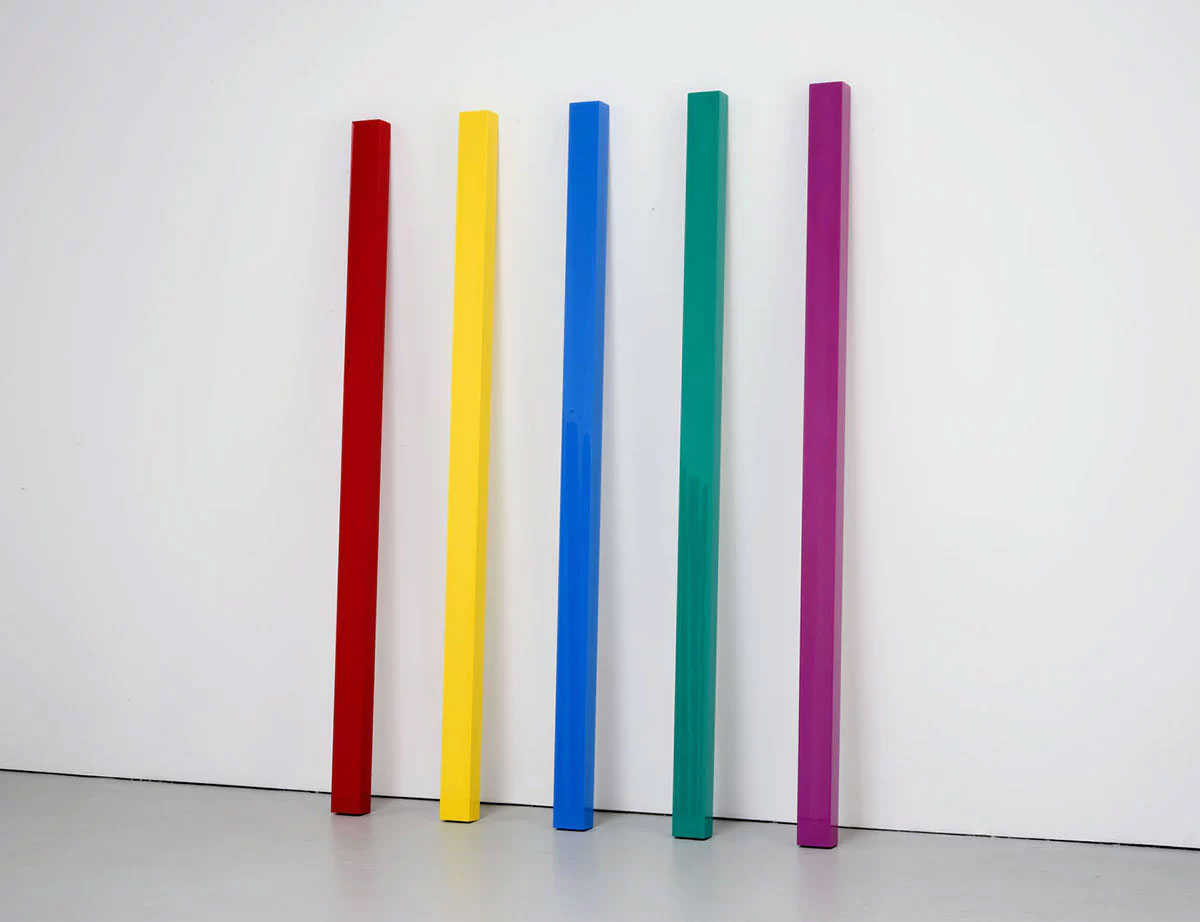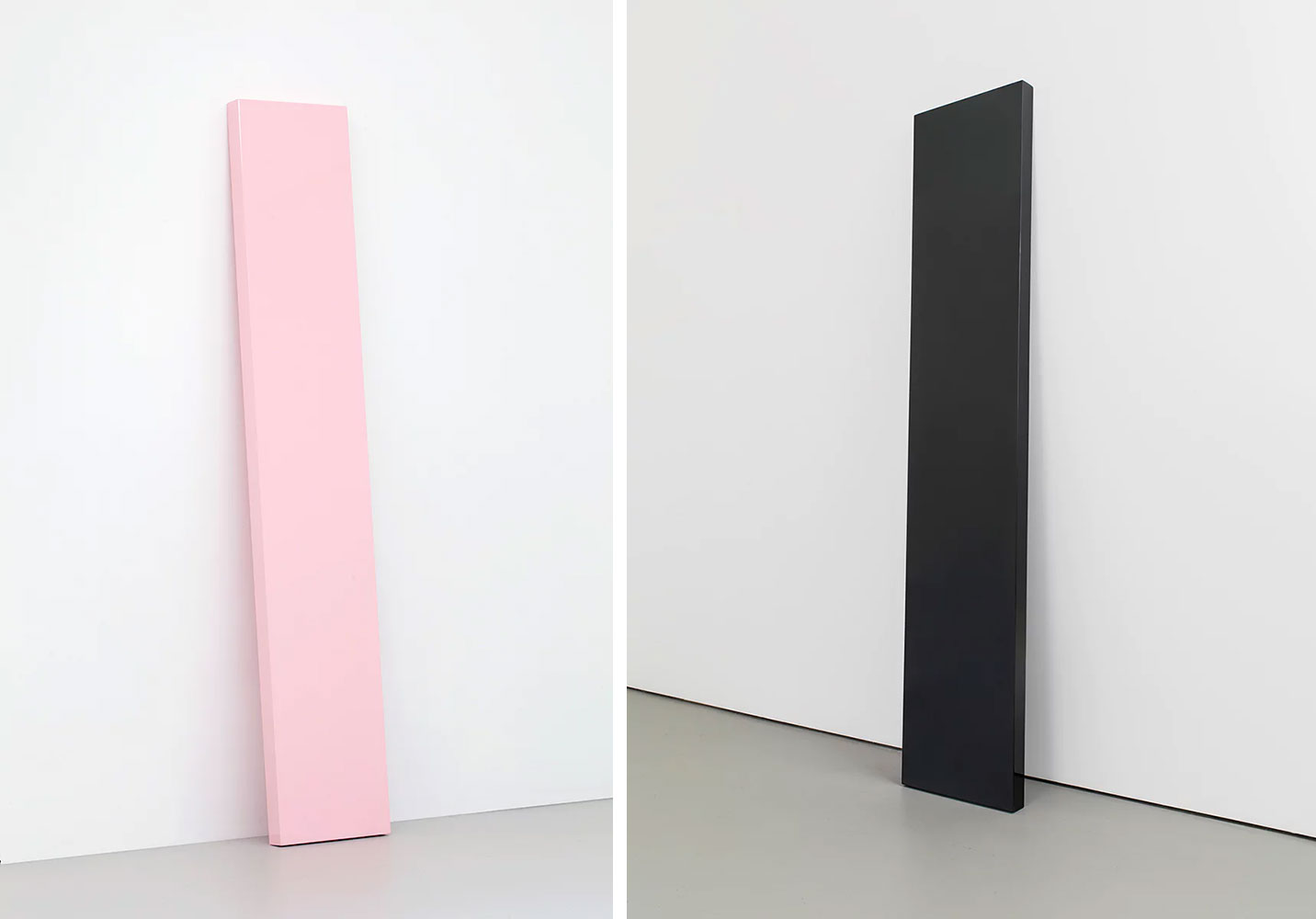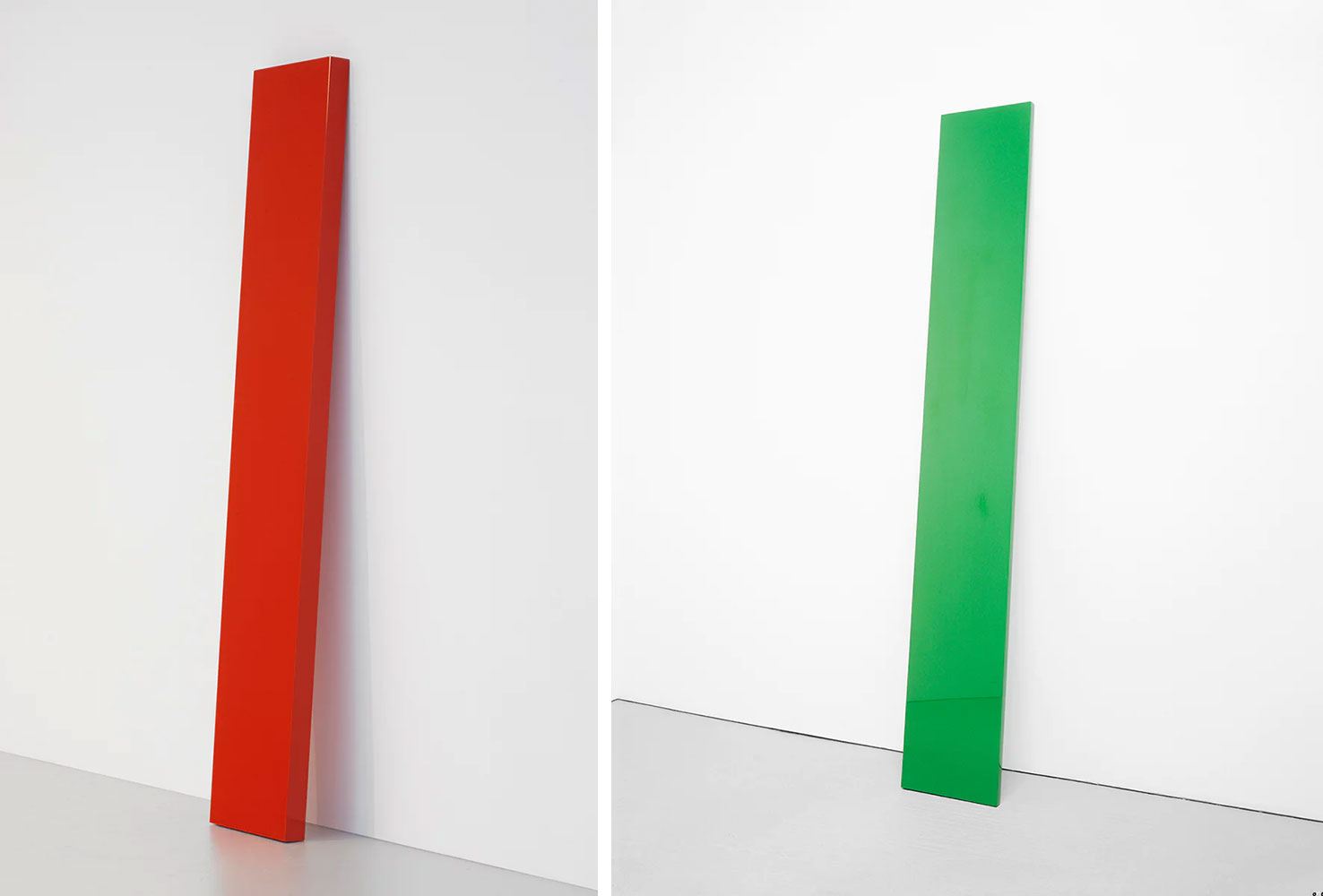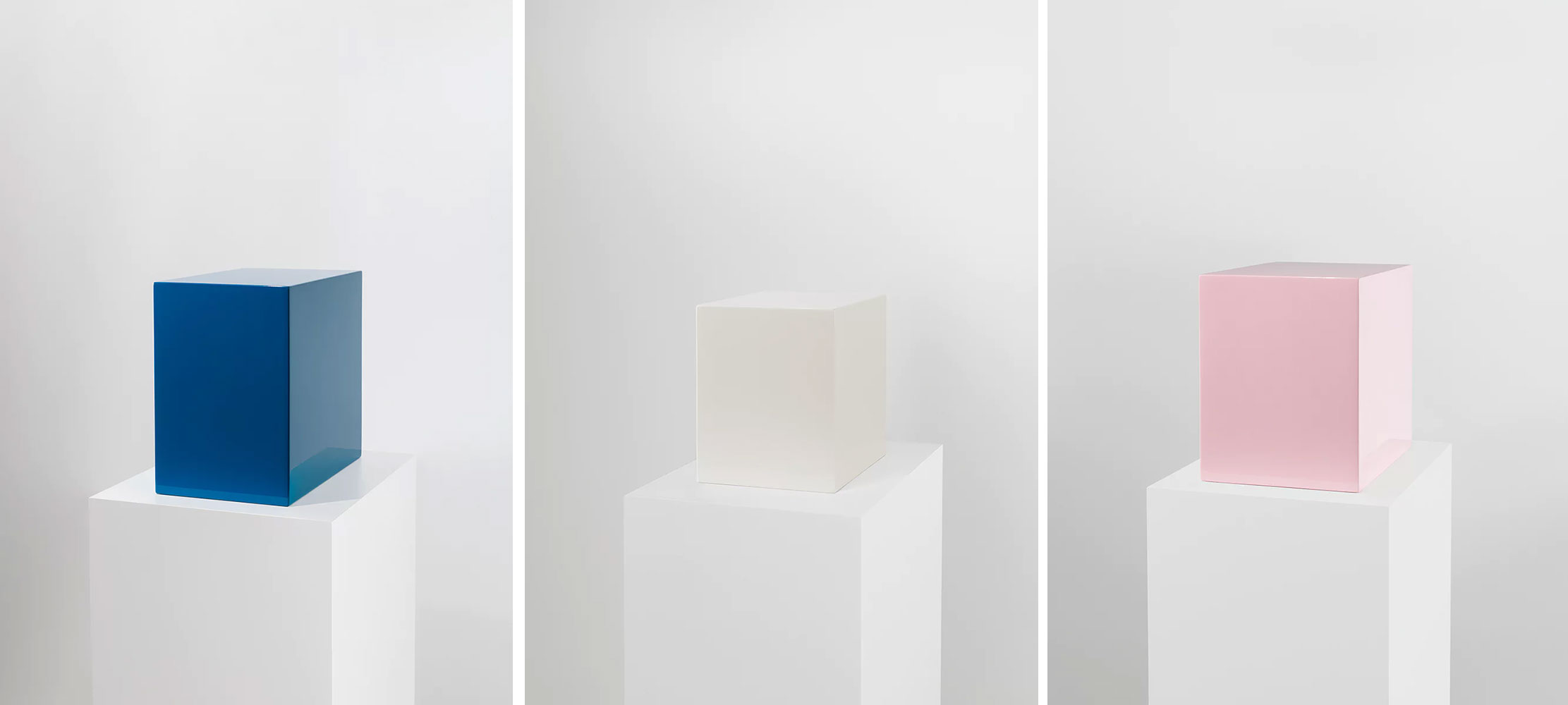PRESENTATION: John McCracken
 John McCracken occupies a singular position within the recent history of American art, as his work melds the restrained formal qualities of Minimalist sculpture with a distinctly West Coast sensibility expressed through color, form, and finish. McCracken developed his early sculptural work while studying painting at the California College of Arts and Crafts in Oakland in the late 1950s and early 1960s. While experimenting with increasingly three-dimensional canvases, the artist began to produce objects made with industrial materials, including plywood, sprayed lacquer, and pigmented resin, creating the highly reflective, smooth surfaces for which he was to become known.
John McCracken occupies a singular position within the recent history of American art, as his work melds the restrained formal qualities of Minimalist sculpture with a distinctly West Coast sensibility expressed through color, form, and finish. McCracken developed his early sculptural work while studying painting at the California College of Arts and Crafts in Oakland in the late 1950s and early 1960s. While experimenting with increasingly three-dimensional canvases, the artist began to produce objects made with industrial materials, including plywood, sprayed lacquer, and pigmented resin, creating the highly reflective, smooth surfaces for which he was to become known.
By Efi Michalarou
Photo: David Zwirner Gallery Archive
Featuring a selection of John McCracken’s signature planks and columns installed in the round, this is the first solo presentation in more than twenty years in Los Angeles, the exhibition illuminates the artist’s nuanced modulation of color, shape, and surface that extended throughout his more than five-decade-long career. McCracken developed his early sculptural work while studying painting at the California College of Arts and Crafts in Oakland in the late 1950s and early 1960s. While experimenting with increasingly three-dimensional canvases, the artist began to create objects made with industrial materials, including plywood, sprayed lacquer, and pigmented resin, resulting in the highly reflective, smooth surfaces for which he would become known. McCracken relocated to LA in the late 1960s and remained a fixture of the burgeoning art scene there through the early 1990s when he moved to Santa Fe, where he would remain for the rest of his life. His work—which has been uniquely influential to subsequent generations of artists—came to represent a distinctively West Coast take on the ascendant minimalist aesthetic coming out of New York in those years. In opposition to the industrially produced, non-referential objects that their East Coast peers were making, McCracken and his contemporaries offered sculptures made from synthetic materials, such as plastic and fiberglass, and highly-finished surfaces, often in combination with light and luminescent shades of color that brought to mind the vivid California sun, LA’s vibrant culture of cars and surfboards, and a multitude of other points of reference. Though sleek in their highly glossed appearance, McCracken’s own geometric forms were handcrafted, meticulously constructed from plywood coated with fiberglass and layers of pigmented polyester resin, taken to such a high polish that they partly reflect the world around them. These works, in particular his planks and columns, exemplify McCracken’s long-standing interest in the transcendent potential of minimalist abstraction and its allowance for myriad readings and associations. The exhibition includes a selection of planks in varying colors and sizes that span the artist’s career. Developed in 1966, the plank became his signature sculptural form: a narrow, rectangular board format that leans at an angle against the wall while simultaneously entering into the three-dimensional realm and physical space of the viewer. For the artist, this format was multivalent, alternately functioning as a gateway to other worlds, a spiritual self-portrait, or simply just a pleasing object to be admired. Color was an integral element of McCracken’s practice, particularly evident in his body of planks. The artist mixed the color of each of these works by hand, keeping careful notes on his recipes and which he felt were successful. The majority of his planks were made in a monochromatic finish, and the artist considered similar or even identical forms executed in differing hues to be entirely individuated artworks that engage with their surroundings in a distinct way. Likewise, McCracken’s columns—strong vertical forms that come in part out of the artist’s interest in ancient Greek and Egyptian architecture, explore the phenomenological relationship between work, viewer, and architecture through their outsized stature. On view is a grouping of rectangular as well as faceted forms that conjure a range of everyday and otherworldly associations. With each column standing around eight feet in height, viewers are able to see themselves and their surroundings fully reflected back in these surfaces. Simultaneously earthbound and ethereal, these works—like many of McCracken’s sculptures—offer viewers an experience that both grounds them where they are and offers vast, open worlds.
Photo: John McCracken, Flare, 2008, Polyester resin, fiberglass and plywood, Overall dimensions: 96 x 72 1/2 x 13 1/2 inches (243.8 x 184.2 x 34.3 cm) 5 parts, each: 96 x 4 1/2 x 3 inches (243.8 x 11.4 x 7.6 cm), Courtesy David Zwirner Gallery
Info: David Zwirner Gallery, 616 North Western Avenue, Los Angeles, CA, USA, Duration: 28/-30/3/2024, Days & Hours: Tue-Sat10:00-18:00, www.davidzwirner.com/

Right: John McCracken, Untitled, 1973, Polyester resin, fiberglass, and plywood , 96 1/4 x 19 1/8 x 2 5/8 inches (244.5 x 48.6 x 6.7 cm), Courtesy David Zwirner Gallery

Right: John McCracken, Green Plank, 1968, Polyester resin, fiberglass, and plywood, 94 1/4 x 14 1/8 x 1 1/4 inches (239.4 x 35.9 x 3.2 cm), Courtesy David Zwirner Gallery

Center: John McCracke, John, 1967, Polyester resin, fiberglass, and plywood, 8 1/2 x 9 x 6 3/4 inches (21.6 x 22.9 x 17.1 cm) , Courtesy David Zwirner Gallery
Right: John McCracken, Untitled (Pink Block), 1968, Polyester resin, fiberglass, and plywooδ, 11 1/8 x 11 7/8 x 8 3/4 inches (28.3 x 30.2 x 22.2 cm), Courtesy David Zwirner Gallery
